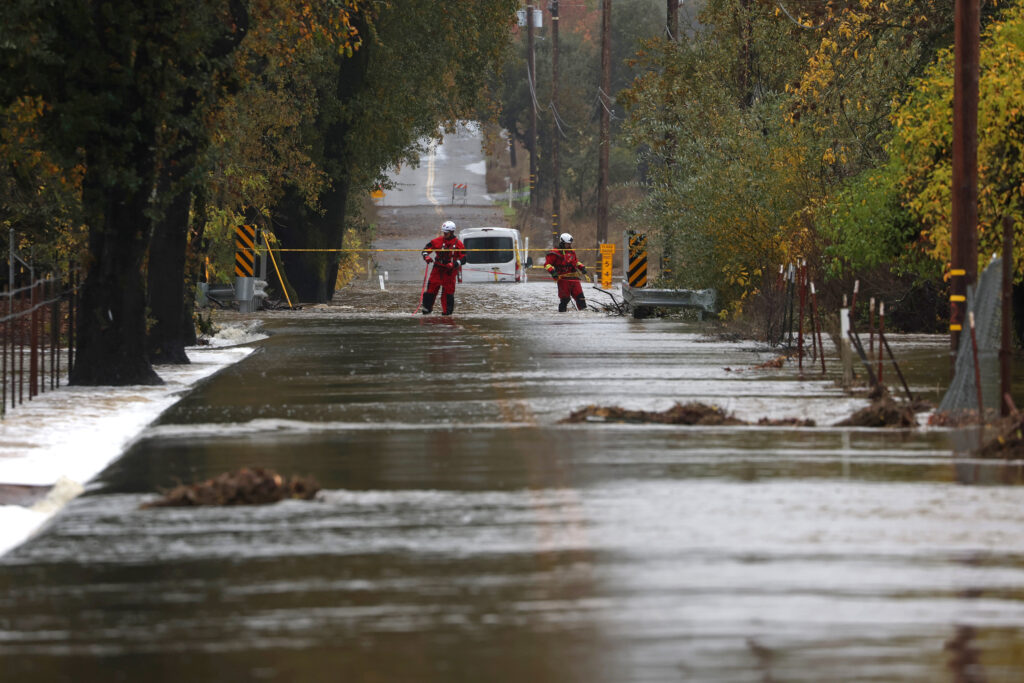Climate Whiplash: A New Threat To Cities Worldwide

Table of Contents
The Impacts of Climate Whiplash on Urban Infrastructure
Climate whiplash places immense strain on urban infrastructure, leading to costly damage and disruptions to essential services.
Damage to Transportation Networks
Roads, bridges, and public transportation systems are particularly vulnerable to the erratic swings in weather patterns.
- Increased maintenance costs: Extreme heat causes road surfaces to buckle and crack, while heavy rainfall leads to potholes and erosion. Bridge structures are weakened by repeated freeze-thaw cycles and flooding.
- Service disruptions: Flooding can completely shut down subway systems and bus routes, causing significant delays and economic losses. Heatwaves can lead to track buckling and power outages, further disrupting service.
- Safety risks: Damaged roads and infrastructure pose significant safety risks to drivers and pedestrians.
- Economic losses: The cost of repairing and replacing damaged infrastructure is substantial, impacting city budgets and potentially delaying crucial development projects.
For example, the London Underground experienced significant flooding in 2021 following a period of intense rainfall, resulting in widespread service disruptions and millions of pounds in repair costs.
Strain on Water and Energy Systems
Unpredictable weather patterns create a double bind for urban water and energy systems.
- Increased energy demand: Heatwaves dramatically increase the demand for electricity for air conditioning, straining power grids and potentially leading to blackouts.
- Water shortages: Prolonged droughts followed by intense rainfall can overwhelm drainage systems, causing both water scarcity and flash flooding. This creates a dangerous cycle of water stress and water damage.
- Power outages: Severe storms can damage power lines and substations, leading to widespread power outages that disrupt essential services, including water treatment plants and hospitals.
The city of Cape Town, South Africa, experienced severe water shortages during a prolonged drought, followed by devastating floods that damaged critical water infrastructure, highlighting the vulnerability of water systems to climate whiplash.
Damage to Buildings and Housing
Buildings are susceptible to damage from both extremes of temperature and precipitation.
- Structural damage: Extreme heat can cause materials to expand and crack, while intense rainfall and flooding can lead to foundation damage and water ingress. Strong winds associated with storms can cause structural failure.
- Increased insurance costs: The increased risk of damage from extreme weather events translates to higher insurance premiums for homeowners and businesses.
- Displacement of residents: Severe damage to buildings can render them uninhabitable, forcing residents to relocate and potentially exacerbating housing shortages.
- Need for resilient building materials and designs: Cities need to adopt building codes that promote the use of resilient materials and construction techniques that can withstand extreme weather events.
Older cities with aging infrastructure are particularly vulnerable to the devastating effects of climate whiplash, necessitating significant investment in upgrades and renovations.
Public Health Consequences of Climate Whiplash
The rapid and unpredictable shifts in weather patterns significantly impact public health.
Increased Heat-Related Illnesses
Fluctuations between extreme heat and cold increase the risk of heatstroke, heat exhaustion, and other heat-related illnesses.
- Increased hospitalizations: Heatwaves can overwhelm healthcare systems with a surge in heat-related emergencies.
- Mortality rates: Heat-related deaths are significantly higher in cities experiencing climate whiplash.
- Improved public health preparedness: Cities need to invest in early warning systems, public cooling centers, and public health campaigns to educate residents about heat-related risks.
Studies show a direct correlation between heatwaves and increased mortality rates in cities experiencing climate whiplash, emphasizing the urgent need for preventative measures.
Spread of Infectious Diseases
Extreme weather events can create breeding grounds for disease vectors.
- Increased risk of waterborne diseases: Flooding can contaminate water sources, increasing the risk of waterborne diseases such as cholera and typhoid.
- Spread of vector-borne illnesses: Changes in temperature and rainfall patterns can alter the distribution and abundance of disease vectors like mosquitoes and ticks, leading to the spread of diseases such as malaria, dengue fever, and Lyme disease.
Cities experiencing climate whiplash often see a surge in infectious diseases following extreme weather events, highlighting the need for robust public health surveillance and interventions.
Mental Health Impacts
The repeated stress of extreme weather events and disruptions to daily life can have profound mental health consequences.
- Increased stress, anxiety, and PTSD: The constant threat of extreme weather events can lead to chronic stress, anxiety, and even PTSD among residents.
- Displacement and loss: The loss of homes, possessions, and community networks due to extreme weather events can have a significant impact on mental wellbeing.
Studies have demonstrated a clear link between extreme weather events and an increase in mental health issues in urban populations, underscoring the importance of providing mental health support services in the face of climate whiplash.
Economic Impacts and Adaptation Strategies for Climate Whiplash
Climate whiplash inflicts considerable economic damage and necessitates proactive adaptation strategies.
Economic Costs of Extreme Weather Events
The economic costs of climate whiplash are substantial and multifaceted.
- Infrastructure repair: Repairing damaged infrastructure after extreme weather events can cost billions of dollars.
- Business losses: Businesses face disruptions, damage, and lost revenue due to extreme weather.
- Healthcare costs: The increase in heat-related illnesses and infectious diseases adds to healthcare costs.
A comprehensive cost-benefit analysis is crucial to evaluate the economic impact and justify investment in climate resilience measures.
Investing in Climate-Resilient Infrastructure
Designing and building infrastructure to withstand extreme weather events is essential.
- Green infrastructure solutions: Green infrastructure, such as urban forests and green roofs, can help to mitigate the effects of heatwaves and floods.
- Early warning systems: Implementing advanced early warning systems can allow cities to better prepare for and respond to extreme weather events.
- Improved drainage systems: Upgrading drainage systems can help to prevent flooding and mitigate the damage caused by heavy rainfall.
- Resilient building codes: Adopting stricter building codes that require the use of resilient materials and construction techniques can help to protect buildings from damage.
Many cities are already investing in climate-resilient infrastructure projects, demonstrating the growing recognition of the need to adapt to the challenges of climate whiplash.
Community-Based Adaptation Measures
Community engagement and preparedness are crucial in mitigating the effects of climate whiplash.
- Community education programs: Educating communities about the risks of climate whiplash and how to prepare for extreme weather events is essential.
- Disaster preparedness plans: Developing and implementing comprehensive disaster preparedness plans can help communities to respond effectively to extreme weather events.
- Early warning systems: Establishing effective early warning systems that reach vulnerable populations is crucial.
Community-based adaptation initiatives have proven effective in enhancing community resilience and reducing the impact of climate whiplash.
Conclusion
Climate whiplash poses a significant and growing threat to cities worldwide, resulting in substantial damage to infrastructure, heightened public health risks, and substantial economic costs. The unpredictable nature of these extreme weather events necessitates urgent action. Policymakers and urban planners must prioritize investments in climate-resilient infrastructure, including green infrastructure solutions, early warning systems, and improved drainage systems. Equally crucial is community-based adaptation: strengthening community preparedness through education, developing robust disaster plans, and ensuring effective communication of early warnings. By acknowledging the severity of climate whiplash and implementing proactive adaptation strategies, cities can build greater resilience and protect their citizens and economies. Further research into the specific vulnerabilities of your own city and the most effective climate whiplash adaptation strategies is paramount to securing a more sustainable urban future.

Featured Posts
-
 The Fentanyl Levels In Princes System March 26th 2016 Report
May 31, 2025
The Fentanyl Levels In Princes System March 26th 2016 Report
May 31, 2025 -
 Understanding The Good Life A Holistic Perspective
May 31, 2025
Understanding The Good Life A Holistic Perspective
May 31, 2025 -
 The Good Life Finding Purpose And Fulfillment
May 31, 2025
The Good Life Finding Purpose And Fulfillment
May 31, 2025 -
 Crepes Saladas Para Merienda O Cena 8 Recetas Variadas
May 31, 2025
Crepes Saladas Para Merienda O Cena 8 Recetas Variadas
May 31, 2025 -
 Canadian Wildfires Smoke Impacts Us As Province Experiences Unprecedented Evacuation
May 31, 2025
Canadian Wildfires Smoke Impacts Us As Province Experiences Unprecedented Evacuation
May 31, 2025
